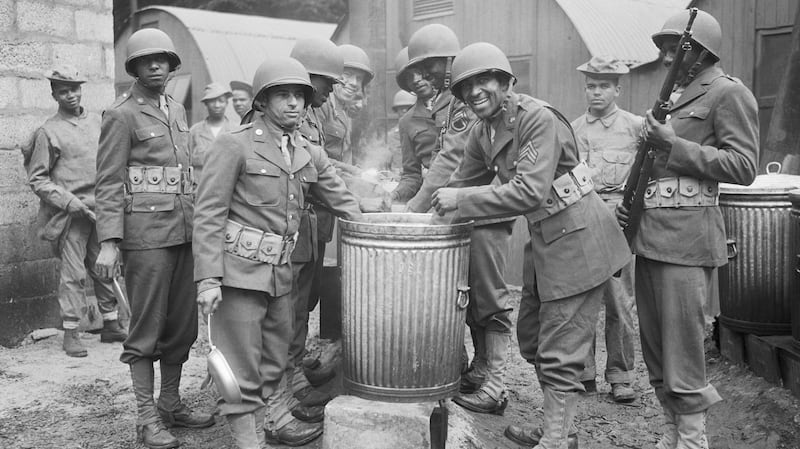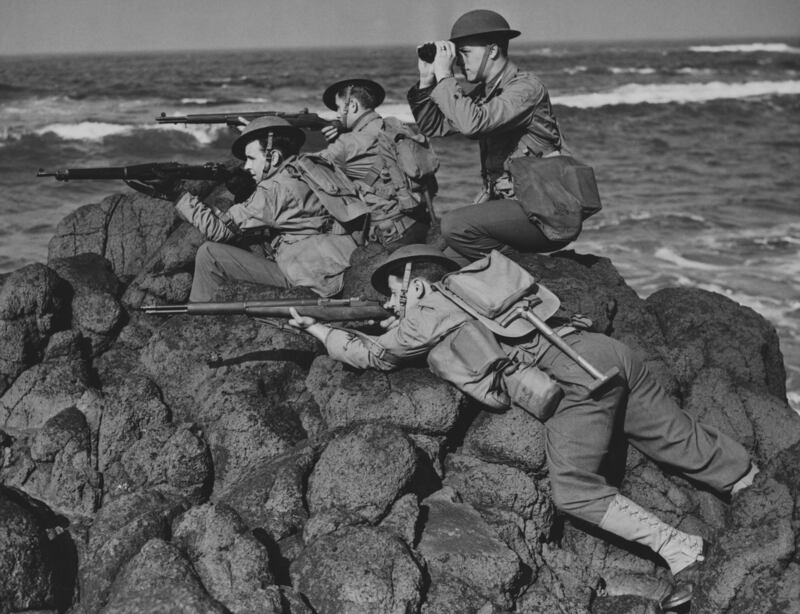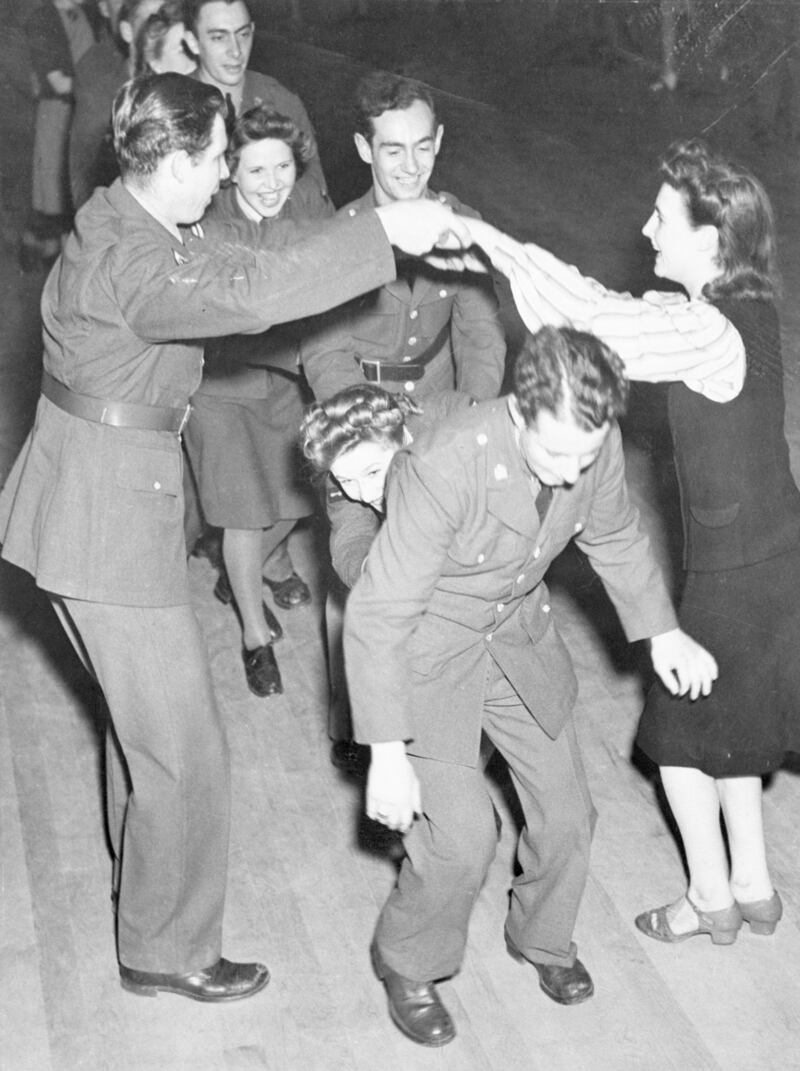In the aftermath of Pearl Harbor, Winston Churchill met Franklin Roosevelt to discuss Allied strategy. Churchill was keen that the Americans immediately commit to winning the war in Europe by sending troops to the United Kingdom. Roosevelt agreed, and announced this on January 6th, 1942.
This caused immediate speculation on both sides of the Irish Border that they would go to Northern Ireland, including from the US consul in Belfast, Parker Buhrman, and the German minister in Dublin, Eduard Hempl, both of whom dismissed rumours. Northern Ireland’s devolved government at Stormont was not party to Anglo-American discussions. Summoned to London to be informed of the decision, prime minister John M Andrews was unperturbed by the lack of consultation, rather he was delighted and honoured to receive the Americans.
Andrews, however, did have concerns. The Americans would replace a British garrison of about 70,000 troops, and he told the war cabinet’s defence committee he was “most anxious that no impression should be given that we were handing over responsibility for the defence of Northern Ireland to the United States. Irresponsible or wrong-minded people might misinterpret this as the first step to handing Northern Ireland over to Éire.”
This concern, indeed paranoia, may have reflected lingering resentment over London’s 1940 offer to Dublin to end partition in return for its participation in the war, also done without consulting Stormont. There was also the matter of internal security amid intermittent IRA violence and sectarian tensions, necessitating retaining some British troops “in case of disorder” because, as the Home Office put it, “it would be preferable if these troops were British”. This implied that American troops could be utilised; the Americans, however, had no desire to police Northern Ireland’s divisions.
There were diplomatic considerations for the British and Americans. Neither country recognised Dublin’s 1937 claim to Northern Ireland; and neither Churchill nor Roosevelt had much tolerance for taoiseach Éamon de Valera or what they perceived as his ungracious neutrality. Consequently, they felt no obligation to tell him of the deployment until it was beyond denial. De Valera duly protested that he “had not been consulted” and called partition “as indefensible as aggressions against small nations elsewhere”.
De Valera avoided escalating existing tensions between Dublin and Washington, epitomised by the mutual antipathy he shared with the US envoy in Dublin, David Gray, by keeping this protest unofficial and, along with nationalism more broadly, opted to simply ignore the American presence. De Valera’s stance was supported by nationalist politicians north of the border, with Patrick Maxwell, nationalist Stormont MP for Derry, comparing the Americans, among other things, to the Germans occupying Norway.

Andrews delighted in de Valera’s discomfort, asserting that Dublin was in “no less danger of invasion”, and “may choose to stand aside. But Northern Ireland is in the fight for freedom, and intends to see it through.” Sir Frederick James Simmons, the 75-year-old unionist mayor of Derry, left his sickbed to simultaneously greet American officers with the Irish welcome Céad Míle Fáilte (“a hundred thousand welcomes”) and berate de Valera’s “impudent protest”.
Prof Douglas Savory, an English-born unionist Westminster MP and historian, characterised de Valera’s statement as “so extraordinary that it was hard to believe that it was authentic”. Unionist bravado masked the reality that Northern Ireland was geographically vital British territory, and technically the Americans no more needed Stormont’s permission to station troops there than de Valera’s.
This was illustrated when Savory failed to secure a public British condemnation of de Valera at Westminster. The official line was, in effect, to leave well enough alone. The Dominions Office told Savory it did “not consider it necessary or desirable for them to issue any reply to that statement. By refraining from doing so, they do not consider that they are in any way ignoring the position of Northern Ireland.”
Public support would have been as welcome as a private commitment was reassuring, but reflected London’s pragmatism preserving ongoing and informal military co-operation with Dublin. A crowd-pleasing outburst from London could have jeopardised this.
The Americans did obliquely acknowledge Dublin’s sensitivities, initially appointing Maj Gen Edmund L Daley, a Catholic of Irish descent, to command US forces. Daley, however, never arrived. He was relieved of command citing “your method of exercising command and its effect on morale’ and an insinuation of an alcohol problem. The Americans, as had the British, nonetheless established good informal links with Éire’s military.

Local political reaction to the Americans divided along sectarian lines and necessitated the hasty (and temporary) inversion of traditional attitudes towards the United States: for nationalists, America was always an ally, which made unionists instinctively suspicious of it.
Unionist papers enthusiastically welcomed the Americans, with the Belfast Telegraph declaring that before Pearl Harbor Roosevelt “was never neutral in mind or heart”. It also contrasted positive British and American press coverage with “the Dublin papers, cramped no doubt by the Censor’s blue pencil, [who] have dismissed the historic event in less than thirty lines”.
The Northern Whig, alongside trying to coax quotations from Doughboys criticising Dublin’s neutrality, gloated that de Valera had received “flattering comment” in German propaganda. Unionist papers also discovered a previously dormant love for America and numerous historic links with the United States, including 13 presidents with Ulster ancestors.
Nationalist newspapers, primarily Belfast’s Irish News and the Derry Journal, invariably took the opposite stance, supporting de Valera’s protest and condemning the arrival as an endorsement of partition and an affront to Ireland’s nationhood. The Journal, for example, questioned the necessity of sending the troops and slammed “the mushroom show of specious regard that the Six County Ascendancy has now conceived for the American Republic”.
The practical consequences interested ordinary Protestants and Catholics more than the constitutional, although both recognised its political significance. A June 1942 Mass Observation report found that Protestants believed that the Americans brought victory closer, but also saw them “almost unconsciously as a strengthening of the forces of order against the constant fear of Catholic (Nationalist) trouble”.

Catholics, on the other hand, were “largely antagonistic, although it is only a minority who are strongly so, many individual Catholics are thoroughly in favour of the Americans”. Buhrman’s analysis tallied with this report. Both communities were welcoming, he reported, and “the initial general hospitality accorded to our troops was greater than could be expected”; if anything, it was a little too enthusiaastic. This transcended sectarian allegiances, as “on its face the troops were received with goodwill only by the Unionist group, actually they were received just as heartily by Nationalist groups”. This represented rare positivity from Buhrman, who fretted endlessly about the Americans’ behaviour and the fear that they might become either victims of, or converts to, violent Irish republicanism.
Unionist politicians and newspapers proffered an idealised loyal, homogenous Northern Ireland, doing its bit for the war, free of the inconvenient realities of a divided society with a disenfranchised and disgruntled minority. Their nationalist counterparts, wary of antagonising American public opinion, largely adhered to their pledge to ignore the Americans, but continued to advertise grievances about partition.
The unconfined joy unionists and apparent outrage of nationalists was reserved very much for the first American deployment, however. As more Americans arrived throughout 1942 and in huge numbers from late 1943, Northern Ireland adjusted to another new wartime routine, joining rationing, blackouts, casualty lists, and fear of air-raids, in which the Americans quickly became a familiar presence.
An indication of the extent that the American presence became normalised appeared in September 1942 in the US army’s magazine Yank: “the Visiting Fireman aura which we had upon arrival has worn off now, as has our novelty, and life has settled down to what it was before we arrived”.
This did not mean that the American presence was unproblematic; the influx of 300,000 young men during the war, peaking at 100,000 (about 10 per cent of the population) in early 1944 was clearly disruptive. The Doughboys were undoubtedly very likeable, but they were also, as the cliche went, “overpaid, oversexed and over here”. They brought with them casual criminality, drunkenness (the latter being the main cause of the former) and Jim Crow racism, issues for any society but potentially more dangerous in the sectarian tinderbox of Northern Ireland.
As for racism, African American troops were generally well-received and appreciated decent treatment from a white population. White Americans, however, informally enforced segregation where they could, particularly around dating, using violence to keep African Americans in their place.
Stormont refused to create a “colour bar” discriminating against African American troops, but often informally facilitated unofficial American segregation, for example, assigning pubs or towns to each race.
The Yanks proved popular with Northern Ireland’s womenfolk which inevitably caused friction with its men. There was a moral panic about the “sort” of women associating with Americans, leading to rising venereal disease rates and prostitution, invariably blamed on “fast” girls and a breakdown in morality. Many Americans, however, found their “Irish Roses”, beginning with the whirlwind marriage of Herbert Cook and Thelma Smith in April 1942, followed by 1,800 more by the war’s end.
Sending American forces to Northern Ireland made sound military and political sense, but its long-term impact is more ambiguous. The American presence perhaps made unionism less insular but it did nothing to lessen sectarianism, recalibrate Stormont’s attitude to the nationalist minority, or signal a new relationship with Dublin. For nationalists it was an interlude to be endured until peace enabled a new anti-partition campaign, on both sides of the Atlantic.
Indeed, while the war drew Northern Ireland closer to Britain, the gulf between the two parts of Ireland was greater than ever. Socially, the American presence may have loosened the shackles of religious conservatism somewhat, but there was no revolution against traditional values. Ultimately, however, the American sojourn can be viewed positively as they were welcomed by both communities. Nevertheless, while Northern Ireland was certainly changed by the Americans, it was not transformed.
Simon Topping is associate professor of United States history at the University of Plymouth and the author of Northern Ireland, the United States and the Second World War (Bloomsbury, 2022)











